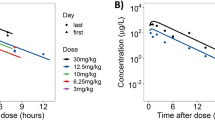Abstract
Purpose: The pharmacodynamics of most drugs follow the empirical relationship, Cn × T=h, where C is drug concentration, T is exposure time and h is drug exposure constant. The value of n indicates the relative importance of C and T in determining the effect. An n value greater than 1.0 indicates that for two infusions that produce the same C × T, a short infusion that delivers high concentrations over a short duration will produce a greater Cn × T and therefore a greater effect, compared to a long infusion that delivers lower concentrations. The reverse is true for an n value less than 1.0 and would support the use of a slow infusion. Hence, it is important to determine the n values and whether the n value significantly differs from 1.0. This report describes a three-step method for this purpose. Methods: First, we obtained experimental data on the relationship between drug concentration, treatment time and effect, and analyzed the data with a three-dimensional surface response method to obtain the pharmacodynamic model parameters and the magnitude of data variability. The experiments used mitomycin C and two human cancer cell lines, i.e. bladder RT4 and pharynx FaDu cells. The n values obtained from four experiments ranged from 1.04 to 1.16 for FaDu cells and from 1.14 to 1.46 for RT4 cells. The variability in the effect data decreased from 11.9% at 0% effect to 6.14% at 100% effect. Second, these results were used with Monte Carlo simulations to generate 100 concentration-time-effect data sets, which contained randomly and normally distributed data variability comparable to the experimentally observed variability, for each experimentally determined n value. This is analogous to performing 100 experiments under the same experimental conditions. Third, we analyzed the simulated data sets to obtain 100 estimated n values. The frequency with which these estimated n values fell above or below 1.0 indicated the probability that the experimentally determined n value used in the Monte Carlo simulations was truly different from 1.0. We defined this frequency for individual experiments as Fone, and calculated the overall probability for multiple experiments (Fmultiple). A probability of greater than 97.5% (i.e. P < 0.05 for a two-tailed test) was considered statistically significant. Results: Analysis of the mitomycin C pharmacodynamic data yielded Fone and Fmultiple of 99% to 100% for FaDu and RT4 cells, indicating that the n values for these cells were significantly higher than 1.0. A comparison of the statistical significance of the n value analyzed by the three-step pharmacodynamic analysis method, a conventional statistical method such as the Student's t-test and nonlinear regression analysis, indicated two advantages for the pharmacodynamic method: fewer experiments were required (theoretically only one experiment with three replicates would be sufficient) and a higher statistical significance of the n value was obtained. Conclusions: In summary, the three-step pharmacodynamic study design and analysis method can be used to define the relative importance of drug concentration and treatment time on drug effect.
Similar content being viewed by others
Author information
Authors and Affiliations
Additional information
Received: 19 May 1999 / Accepted: 15 September 1999
Rights and permissions
About this article
Cite this article
Millenbaugh, N., Wientjes, M. & Au, JS. A pharmacodynamic analysis method to determine the relative importance of drug concentration and treatment time on effect. Cancer Chemother Pharmacol 45, 265–272 (2000). https://doi.org/10.1007/s002800050039
Issue Date:
DOI: https://doi.org/10.1007/s002800050039




